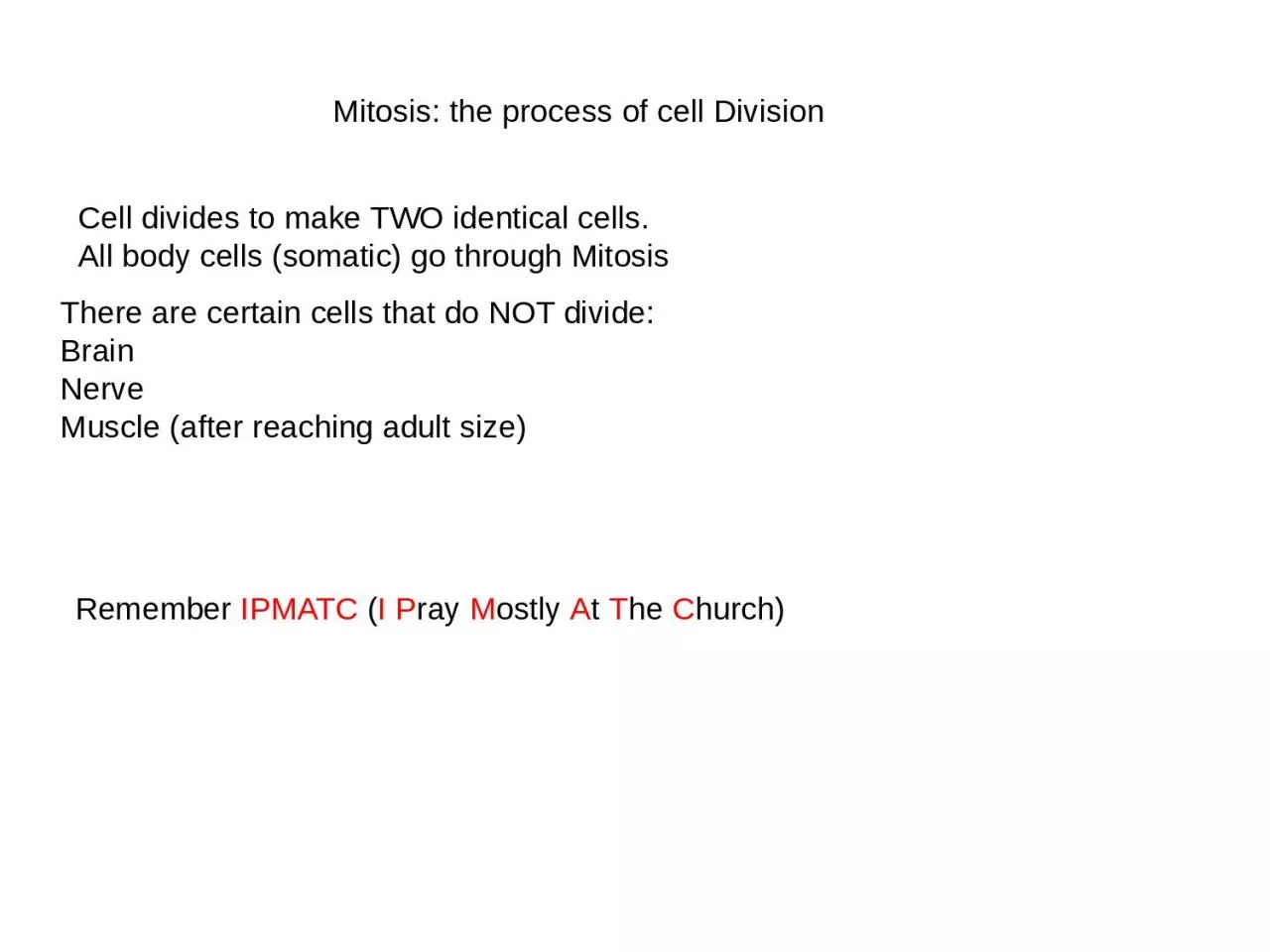

There are certain cells that do NOT divide Brain Nerve Muscle after reaching adult size Remember IPMATC I P ray M ostly A t T he C hurch Cell divides to make TWO identical cells ID: 1042485
Download Presentation The PPT/PDF document "Mitosis: the process of cell Division" is the property of its rightful owner. Permission is granted to download and print the materials on this web site for personal, non-commercial use only, and to display it on your personal computer provided you do not modify the materials and that you retain all copyright notices contained in the materials. By downloading content from our website, you accept the terms of this agreement.
1. Mitosis: the process of cell DivisionThere are certain cells that do NOT divide: BrainNerveMuscle (after reaching adult size)Remember IPMATC (I Pray Mostly At The Church)Cell divides to make TWO identical cells. All body cells (somatic) go through Mitosis
2. Skin cancer - the abnormal growth of skin cells - most often develops on skin exposed to the sun. Cell that reproduce by asexual reproduction reproduce constantly. Three reasons why cells reproduce by asexual reproduction: 1. Growth 2. Repair 3. Replacement
3.
4.
5. INTERPHASEG1 phase. Metabolic changes prepare the cell for division. At a certain point - the restriction point - the cell is committed to division and moves into the S phase.S phase. DNA synthesis replicates the genetic material. Each chromosome now consists of two sister chromatids.G2 phase. Metabolic changes assemble the cytoplasmic materials necessary for mitosis and cytokinesis.M phase. A nuclear division (mitosis) followed by a cell division (cytokinesis).The period between mitotic divisions - that is, G1, S and G2 - is known as interphase
6.
7.
8.
9. Prophase-Prophase occupies over half of mitosis. -The nuclear membrane breaks down to form a number of small vesicles and the nucleolus disintegrates.-A structure known as the centrosome duplicates itself to form two daughter centrosomes that migrate to opposite ends of the cell. -The centrosomes organize the production of microtubules that form the spindle fibers that constitute the mitotic spindle. -The chromosomes condense into compact structures. Each replicated chromosome can now be seen to consist of two identical chromatids (or sister chromatids) held together by a structure known as the centromere.
10. Prophase
11.
12. METAPHASEThe chromosomes, led by their centromeres, migrate to the equatorial plane in the midline of cell - at right-angles to the axis formed by the centrosomes. This region of the mitotic spindle is known as the metaphase plate. The spindle fibres bind to a structure associated with the centromere of each chromosome called a kinetochore. Individual spindle fibres bind to a kinetochore structure on each side of the centromere. The chromosomes continue to condense.The chromosomes align themselves along the metaphase plate of the spindle apparatus.
13. METAPHASE
14. ANAPHASEThe shortest stage of mitosis. The centromeres divide, and the sister chromatids of each chromosome are pulled apart - or 'disjoin' - and move to the opposite ends of the cell, pulled by spindle fibres attached to the kinetochore regions. The separated sister chromatids are now referred to as daughter chromosomes. (It is the alignment and separation in metaphase and anaphase that is important in ensuring that each daughter cell receives a copy of every chromosome.)
15. ANAPHASE
16. TELOPHASEThe final stage of mitosis, and a reversal of many of the processes observed during prophase. The nuclear membrane reforms around the chromosomes grouped at either pole of the cell, the chromosomes uncoil and become diffuse, and the spindle fibres disappear.
17. TELOPHASE
18. CYTOKINESISThe final cellular division to form two new cells. In plants a cell plate forms along the line of the metaphase plate; in animals there is a constriction of the cytoplasm. The cell then enters interphase - the interval between mitotic divisions
19. Cytokinesis in plants
20.
21.